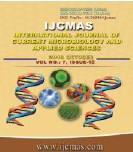


 National Academy of Agricultural Sciences (NAAS)
National Academy of Agricultural Sciences (NAAS)

|
PRINT ISSN : 2319-7692
Online ISSN : 2319-7706 Issues : 12 per year Publisher : Excellent Publishers Email : editorijcmas@gmail.com / submit@ijcmas.com Editor-in-chief: Dr.M.Prakash Index Copernicus ICV 2018: 95.39 NAAS RATING 2020: 5.38 |
For the proper utilization of the national breeding material sponsored in the All India Coordinated Cotton Improvement Project (AICCIP) of the Indian Council of Agricultural Research (ICAR), the study was conceived to examine the variability, heritability and genetic gain over a decade period (2003 to 2012) for the progress achieved for enhancing the productivity. The field experiments were conducted during these years of Kharif seasons on 27, 31, 32, 40, 40, 36, 39, 42, 42 and 45 genotypes in randomized complete block design with three replications at Central Institute for Cotton Research, Regional Station, Sirsa, Haryana. For a decade within all the years Genotypic coefficient of variation were found almost lower than the phenotypic coefficient of variation for all the traits viz., seed cotton yield, ginning outturn percent, lint yield, boll no. per plant and boll weight indicating preponderance of environmental variation over genotypic variation. For all the years, heritability (85.04 to 99.46% and 78.94 to 99.54%) and genetic gain (417.8 to 897.83 and 152.20 to 300.05) values were very high for seed cotton yield and lint yield respectively. Genetic gain was low to moderate for ginning outturn%, boll no. per plant and boll weight for all the years ranging from 0.90 to 2.36, 2.28 to 7.24 and 0.22 to 1.80 respectively, though for these traits heritability was very high similar to seed cotton yield and lint yield. The study suggested operation of additive gene action for seed cotton yield and lint yield and both additive and non-additive gene action for ginning outturn, boll no. per plant and boll weight. Comparison of genetic component analysis from the average over ten years indicated that during 2003 seed cotton yield, lint yield and boll no. per plant were significantly higher than the average whereas in 2012 seed cotton yield, lint yield and boll weight were significantly higher than this average. The study also indicated from the experimentation on the material sponsored by the breeders in the initial evaluation trial of G. hirsutum (irrigated) over a decade that there was no specific trend for enhancement of seed cotton yield and its component traits under study.
 |
 |
 |
 |
 |